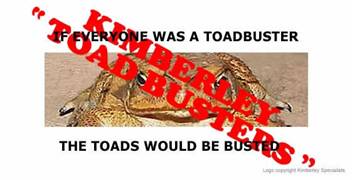A heartfelt cry from the Kununurra Community to the Nation now fighting to stop the cane toad from crossing into WA since Sept. 2004. We will Stop the Cane Toads getting into WA! |
 |
|
Media Release
KTBs Dutch Research Student finds Lungworm Rhahbias cf hylae in Cane Toads at the Western Colonising Front!!
How Did This Discovery Happen? TAKE Delft University in Netherlands + Dutch student keen to study and adventure with the toadbusters, and improve his English + KTB website www.canetoads.com.au (averaging 700 hits a day one of which one was our Dutch student) + one Visa to study with toadbusters (just imagine explaining that one to immigration! - thanks to KTB volunteer Ade Meredith for this) + KTBs willing to sponsor student + lots of busted colonising toads + makeshift laboratory = Discovery of lungworm in front line colonising cane toads
What is the Discovery? The Lungworm Rhahbias cf hylae infects native frogs. Native frogs pass the lungworm onto cane toads. Lungworms make cane toads sick and adversely impact on the cane toads’ breeding ability, making the lungworm a potential weapon in the fight to stop the cane toad. As the KTBs understand the situation, it has been believed by cane toad research scientists that lungworms are not present in the colonising front line cane toads and that lungworms are well behind the frontline toads by up to a twenty years catch-up period. Why is this discovery important? It is known that Australian native frogs and cane toads in Queensland have been harmed and diminished by the lungworm. The lungworm kills small and immature cane toads, and metamorphs. Cane toads infected with parasites are unlikely to travel! Until the recent KTB discovery, there had been insufficient research on whether this lungworm might/or might not be present in toads and native frogs at colonising cane toad ‘fronts’, such as the front moving towards the WA East Kimberley from the NT. “Understanding where, when and how lung worms infect toads may lead us to a control mechanism for cane toads, and this gives us cause for hope”, said Lee Scott-Virtue. In his ground breaking research, Jordy has also found other parasites in the cane toads he has autopsied. Dr Di Barton, one of Australia’s leading frog parasitologists has recently been helping the KTBs and has told the KTBs that, No-one had taken a “whole host” point of view before I did – which was to list ALL the parasites found from a host species … the actual parasite fauna of most of Australia’s frogs is unknown”. And The toads should be infected with other things – especially nematodes in the intestinal tract as these are almost everywhere. The only way that you can say for sure that the parasites came from local frogs is to dissect some,” adds Dr Barton. The KTBs have sent a letter to the DEC asking for help in obtaining permits to dissect selected native frogs and while any other mechanism would be preferable, this is so important that we will grit our teeth in the name of this critical science, trust that the State government will share out view and give us the permits we need as a matter of urgency”, said Lee Scott-Virtue. Only about 50% of frogs have been recorded as a host for anything and most of those have never been subject to an intensive survey for their parasite fauna”, Dr Barton. Everything that we learn about cane toads and the things that infect them takes us closer to an eradication mechanism for cane toads that is safe for Australian fauna,” said Sarah Brett, Kununurra veterinarian and Vice President of the KTBs.
Jordy’s aptitude for the toadbust now sees him supervising toadbusting volunteer teams in the field. He has even toadbusted with our WA Minister for the Environment, the Hon. David Templeman. Jordy Groffen’s project asks the specific scientific question: Is the lungworm Rhabdias cf hylae present in cane toads at the cane toad front moving towards the WA/NT border? Jordy’s Groundbreaking Discovery After less than 2 months in the field Jordy has conclusively determined that the lungworm is present in 80% of toads less than 2 years behind the front. “I now expect to find cane toads infected even closer to the frontline colonisers” said Jordy. He added, “This is an incredible breakthrough and if we could confirm that the native frog species responsible for passing on this lungworm were also present at the very frontline areas there is the possibility we could drop infected toads into these areas without any adverse impacts on native species. This would significantly hasten the adverse impact of the lungworm on the cane toad and might result in a massive reduction in numbers and resilience of toads in any given area”. Jordy confirmed that there is an urgent need to determine how many species of native Kimberley frogs had the lungworm before any infected toads could be dropped into frontline areas. He went on to state that, “Infected toads would also need to be ‘tagged’ and monitored to ensure toad busting teams did not remove them during a bust”. Dr Diane Barton, one of Australia’s leading Australian frog parasitologists has confirmed Jordy’s lungworm discoveries.Jordy’s research project will also develop an inventory of parasite species identified in colonising Cane Toads.
KTB MEDIA RELEASE 10 April 2008
Use of the photos in this media release must be authorised by the KTBs and the photographer acknowledged
For more information contact:
Lee Scott Virtue: Founder&President KTBs based in Kununurra&Nicholson Station 9168 7080
Sandy Boulter: Photos, Media, Coordinator Perth based Friends of the KTBs: 0427 508 582
Dr Di Barton: 0417 190 470
Jordy Groffen: KTB Kununurra Field Office: 08 9168 2576
|

_img_0.jpg)
_img_1.jpg)
_img_2.jpg)
_img_4.jpg)
_img_3.jpg)
_img_5.jpg)
_img_6.jpg)
_img_8.jpg)
_img_9.jpg)